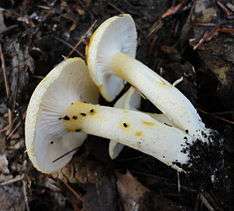Hygrophorus
| Hygrophorus | |
|---|---|
| | |
| Hygrophorus eburneus | |
| Scientific classification | |
| Kingdom: | Fungi |
| Division: | Basidiomycota |
| Class: | Agaricomycetes |
| Order: | Agaricales |
| Family: | Hygrophoraceae |
| Genus: | Hygrophorus Fr. (1836) |
| Type species | |
| Hygrophorus eburneus (Bull.) Fr. (1838) | |
| Synonyms | |
Hygrophorus is a genus of agarics (gilled mushrooms) in the family Hygrophoraceae. Called "woodwaxes" in the UK or "waxy caps" (together with Hygrocybe species) in North America, basidiocarps (fruit bodies) are typically fleshy, often with slimy caps and lamellae that are broadly attached to decurrent. All species are ground-dwelling and ectomycorrhizal (forming an association with living trees) and are typically found in woodland. Around 100 species are recognized worldwide. Fruit bodies of several species are considered edible and are sometimes offered for sale in local markets.
Taxonomy
History
Hygrophorus was first published in 1836 by Swedish mycologist Elias Magnus Fries. The generic name is derived from the Greek ῦγρὁς (= moist) + φόρος (= bearer), with reference to the slimy caps found in many species.[1] Fries (1849) subsequently split the genus into three subgenera: Limacium, Camarophyllus, and Hygrocybe. The last of these is now recognized as a genus in its own right, but was frequently included within Hygrophorus until the 1970s.[1][2] Camarophyllus (type species Hygrophorus camarophyllus) and Limacium were also raised to the rank of genus, but are regarded as synonyms of Hygrophorus.[3][4][5][6] Camarophyllus sensu Singer (based on Hygrocybe pratensis) is, however, a synonym of Hygrocybe (or Cuphophyllus).
Current status
Recent molecular research, based on cladistic analysis of DNA sequences, suggests that Hygrophorus (minus Hygrocybe) is a monophyletic (and hence natural) genus. Only a few species, however, have been sequenced to date.[7]
Description
Fruit bodies of Hygrophorus species are all agaricoid, most (but not all) having smooth caps that are viscid to glutinous when damp. The lamellae beneath the cap are usually distant, thick, waxy, and broadly attached to decurrent. The stems of Hygrophorus species often have traces of a glutinous veil, sometimes forming an equally glutinous ring or ring-zone. The spore print is white. Microscopically, Hygrocybe species lack true cystidia and have smooth, inamyloid basidiospores.[8]
Habitat and distribution
Species of Hygrophorus are ectomycorrhizal, most forming associations with trees (both broadleaf and conifer) and hence typically found in woodlands. Many appear to be host specific, Hygrophorus cossus, for example, occurring with oak and H. speciosus with larch.[2][9]
Species are distributed worldwide, from the tropics to the sub-polar regions. Around 100 have been described to date.[10]
Economic usage
Fruit bodies of a few species are considered edible and are collected and consumed locally (sometimes sold in markets) in Spain and eastern Europe, China and Bhutan, and Central America .[11]
Literature
No comprehensive monograph of the genus has yet been published. In Europe, however, species of Hygrophorus have been illustrated and described in an Italian guide by Candusso (1997).[9] European species have also been covered, more briefly, in descriptive French keys by Bon (1990).[12] Dutch species were illustrated and described by Arnolds (1990).[8] No equivalent modern guides have been published for North America, the most recent being by Hesler & Smith (1963).[2] There is, however, a guide to Californian species by Largent (1985).[13] In Australia, Hygrophorus species have been illustrated and described by Young (2005)[14] and in New Zealand by Horak (1990).[15]
Species
See also
References
- 1 2 Rea C. (1922). British Basidiomycetaceae: A Handbook of the Larger British Fungi. Cambridge, UK: Cambridge University Press. p. 799.
- 1 2 3 Hesler LR, Smith AH (1963). North American species of Hygrophorus. University of Tennessee Press. p. 416.
- ↑ "Camarophyllus (Fr.) P. Kumm.". Index Fungorum. CAB International. Retrieved 2011-09-25.
- ↑ "Camarophyllus (Fr.) P. Kumm.". MycoBank. International Mycological Association. Retrieved 2011-09-25.
- ↑ "Limacium (Fr. ex Rabenh.) P. Kumm.". Index Fungorum. CAB International. Retrieved 2011-09-25.
- ↑ "Limacium (Fr. ex Rabenh.) P. Kumm.". MycoBank. International Mycological Association. Retrieved 2011-09-25.
- ↑ Matheny PB, Curtis JM, Hofstetter V, Aime MC, Moncalvo JM, Ge ZW, Slot JC, Ammirati JF, Baroni TJ, Bougher NL, Hughes KW, Lodge DJ, Kerrigan RW, Seidl MT, Aanen DK, DeNitis M, Daniele GM, Desjardin DE, Kropp BR, Norvell LL, Parker A, Vellinga EC, Vilgalys R, Hibbett DS (2006). "Major clades of Agaricales: a multilocus phylogenetic overview" (PDF). Mycologia. 98 (6): 982–95. PMID 17486974. doi:10.3852/mycologia.98.6.982. Archived from the original (PDF) on 2016-03-03.
- 1 2 Arnolds E. (1990). Genus Hygrophorus in Flora Agaricina Neerlandica 2. Lisse, Netherlands: AA Balkema. pp. 115–133. ISBN 90-6191-971-1.
- 1 2 Candusso M. (1997). Fungi Europaei 6: Hygrophorus s.l.. Alassio, Italy: Libreria Basso. p. 784.
- ↑ Kirk PM, Cannon PF, Minter DW, Stalpers JA (2008). Dictionary of the Fungi (10th ed.). Wallingford, UK: CAB International. p. 446. ISBN 978-0-85199-826-8.
- ↑ Boa ER. (2004). Wild Edible Fungi: A Global Overview of Their Use and Importance to People. Food and Agriculture Organization of the United Nations. p. 147. ISBN 92-5-105157-7.
- ↑ Bon M. (1990). Flore mycologique d'Europe 1: Les Hygrophores (in French). Amiens Cedex: CRDP de Picardie. p. 99.
- ↑ Largent DL. (1985). The Agaricales (Gilled Fungi) of California 5: Hygrophoraceae. Eureka, California: Mad River Press. p. 220. ISBN 0-916422-54-2.
- ↑ Young AM. (2005). Fungi of Australia: Hygrophoraceae. Collingwood, Victoria: CSIRO Publishing. p. 188. ISBN 978-0-643-09195-5.
- ↑ Horak E. (1990). "Monograph of the New Zealand Hygrophoraceae (Agaricales)" (PDF). New Zealand Journal of Botany. 28: 255–309. doi:10.1080/0028825x.1990.10412313.



